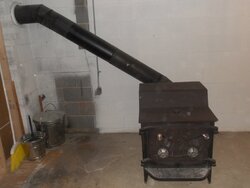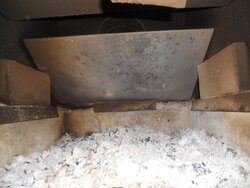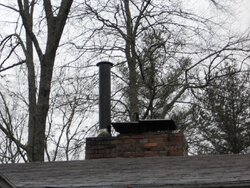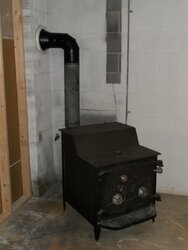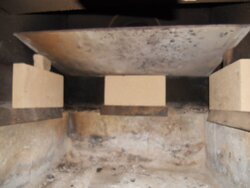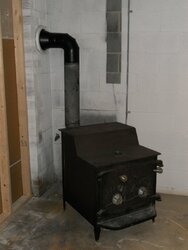Wow, this forum is amazing. Having had several periods of wood heating in my younger years I thought I knew how to set up my new (old) Grandma but boy do I learn a lot on here.
I have a 50 year old house with masonry chimney with 3 flues. Fireplace second floor, fireplace in finished basement, and extra flue in basement originally for oil furnace. I removed the oil furnace and connected Grandma Fisher. The stove is about 6 feet from the chimney and has 8" pipe leaving the stove back by elbow then running about 6 feet to the chimney at about 45 deg angle and enters the masonry inlet about 6 feet from the floor, then upward about 25 feet out the top. I have damper in the first section after the elbow leaving the stove that usually is closed to 80-90% during operation.
I had the steel baffle plate made per forum recommendations and propped it upright on firebricks sitting vertically on top of the lower course and got the 2 inch gap right at the rise. The stove burns long and hot and nearly smokeless, temps on stove top usually 400 - 600,
Because of a slight downdraft in the other chimney I was initially getting smoke smell in house. It is a heat pump with too much return but too much to fix now so I extended the masonry chimney with stovepipe up about five more feet and solved that, maybe helping the chimney draw too?
My concern is the cool pipe. At the last section where it enters the chimney it is often cool enough to lay hand on it. Temp below the damper is typically below 150 and above almost unmeasurable. After a few weeks burning I can hear and feel creosote? build up crunching around the damper when turned and I am becoming concerned.
Any advice appreciated.
Smokey
I have a 50 year old house with masonry chimney with 3 flues. Fireplace second floor, fireplace in finished basement, and extra flue in basement originally for oil furnace. I removed the oil furnace and connected Grandma Fisher. The stove is about 6 feet from the chimney and has 8" pipe leaving the stove back by elbow then running about 6 feet to the chimney at about 45 deg angle and enters the masonry inlet about 6 feet from the floor, then upward about 25 feet out the top. I have damper in the first section after the elbow leaving the stove that usually is closed to 80-90% during operation.
I had the steel baffle plate made per forum recommendations and propped it upright on firebricks sitting vertically on top of the lower course and got the 2 inch gap right at the rise. The stove burns long and hot and nearly smokeless, temps on stove top usually 400 - 600,
Because of a slight downdraft in the other chimney I was initially getting smoke smell in house. It is a heat pump with too much return but too much to fix now so I extended the masonry chimney with stovepipe up about five more feet and solved that, maybe helping the chimney draw too?
My concern is the cool pipe. At the last section where it enters the chimney it is often cool enough to lay hand on it. Temp below the damper is typically below 150 and above almost unmeasurable. After a few weeks burning I can hear and feel creosote? build up crunching around the damper when turned and I am becoming concerned.
Any advice appreciated.
Smokey
Attachments
Last edited:


